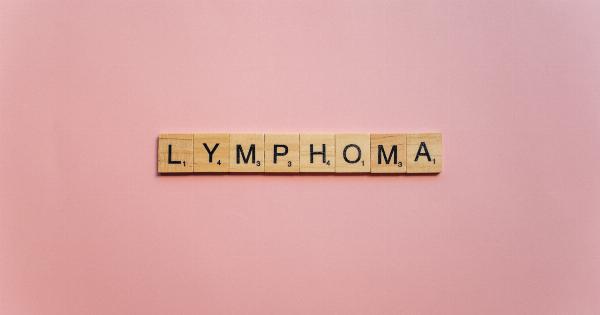Lymphoma is a type of cancer that begins in immune system cells called lymphocytes. There are two main types of lymphoma: Hodgkin lymphoma (HL) and non-Hodgkin lymphoma (NHL).
This comprehensive guide is designed to help you understand lymphoma and its various aspects such as types, symptoms, diagnosis, treatment options, and much more.
Types of Lymphoma
There are two main types of lymphoma:.
Hodgkin Lymphoma (HL)
Hodgkin lymphoma is a cancer of the lymph system. It is characterized by the presence of a particular type of cell called a Reed-Sternberg cell. The cause of HL is unknown. It commonly affects young adults and is more common in men than women.
The symptoms of Hodgkin lymphoma may include fever, night sweats, weight loss, and swollen lymph nodes, which may or may not be painful. Treatment options for HL include chemotherapy, radiation therapy, stem cell transplant, and targeted therapy.
Non-Hodgkin Lymphoma (NHL)
Non-Hodgkin lymphoma is a cancer of the lymph system that does not involve the Reed-Sternberg cell. NHL can start anywhere in the body, including the lymph nodes, spleen, bone marrow, and other organs.
The cause of NHL is unknown, but it is more common in people with weakened immune systems and those who have been exposed to certain chemicals or viruses. The symptoms of NHL may include fever, night sweats, weight loss, swollen lymph nodes, and fatigue. Treatment options for NHL include chemotherapy, radiation therapy, stem cell transplant, and immunotherapy.
Causes of Lymphoma
The cause of lymphoma is not yet known. However, research has shown that several factors may increase the risk of developing the disease. Some of these factors include:.
- Age: Lymphoma can occur at any age, but it is more common in people over 60 years old.
- Gender: Hodgkin lymphoma is more common in males, while non-Hodgkin lymphoma is more common in females.
- Previous cancer treatment: People who have received radiation therapy or chemotherapy for other types of cancer have an increased risk of developing lymphoma.
- Immunodeficiency: People with weakened immune systems are at an increased risk of developing lymphoma.
- Infections: Certain viral infections such as HIV, Epstein-Barr virus, and hepatitis C virus have been associated with an increased risk of developing lymphoma.
Symptoms of Lymphoma
The symptoms of lymphoma can vary depending on the type of lymphoma and where it is located in the body. The most common symptoms of lymphoma include:.
- Swollen lymph nodes in the neck, groin, or armpit.
- Fever
- Unexplained weight loss
- Night sweats
- Fatigue
- Shortness of breath
- Chest pain or coughing
- Abdominal pain or swelling
It is important to note that these symptoms may indicate other medical conditions, so it is essential to consult a healthcare professional immediately if you experience any of these symptoms.
Diagnosis of Lymphoma
Diagnosing lymphoma can be challenging, as the symptoms can be vague and similar to those of other medical conditions. The diagnosis usually involves a combination of physical examination, blood tests, imaging tests, and biopsy.
Physical examination: Your doctor will perform a physical exam to check for swelling of your lymph nodes, liver, and spleen.
Blood tests: Blood tests may include a complete blood count, liver function tests, and viral infection tests. These tests help to determine the health of your blood cells, liver, and immune system.
Imaging tests: Imaging tests such as X-rays, CT scans, PET scans, and MRI scans may be performed to help determine the location and size of the lymphoma mass.
Biopsy: A biopsy involves removing a small piece of tissue from a lymph node or other affected body part. The sample is then tested for the presence of cancer cells.
Treatment Options for Lymphoma
The treatment options for lymphoma depend on the type and stage of the cancer, as well as the patient’s overall health and age. The main treatment options for lymphoma include:.
Chemotherapy
Chemotherapy is a type of cancer treatment that involves using drugs to kill cancer cells. Chemotherapy drugs can be taken orally or injected into a vein. The drugs travel throughout the body and destroy cancer cells wherever they are located.
Radiation therapy
Radiation therapy uses high-energy X-rays or other types of radiation to kill cancer cells. Radiation therapy can be directed at a specific area of the body or given to the entire body.
Stem cell transplant
A stem cell transplant involves replacing the patient’s diseased bone marrow with healthy bone marrow cells. The new bone marrow cells can come from the patient (autologous transplant) or from a donor (allogeneic transplant).
Immunotherapy
Immunotherapy is a type of cancer treatment that stimulates the immune system to attack cancer cells. Immunotherapy can be given as a drug or through a vaccine.
Living with Lymphoma
Living with lymphoma can be challenging, but there are many resources available to help patients and their families cope with the disease.
Support groups, counseling, and other forms of emotional support can be beneficial for those dealing with the challenges of cancer.
It is important to maintain a healthy lifestyle, including eating a healthy diet, getting regular exercise, and avoiding tobacco and excessive alcohol consumption.
Patients with lymphoma should also have regular check-ups with their healthcare providers to monitor their condition and adjust treatment as needed.
Conclusion
Lymphoma is a cancer that can affect anyone, regardless of age or gender. However, treatment options are available, and many patients are able to achieve remission and lead healthy lives.
By understanding the types, symptoms, diagnosis, and treatment options for lymphoma, patients and their families can make informed decisions and take an active role in their healthcare.



























